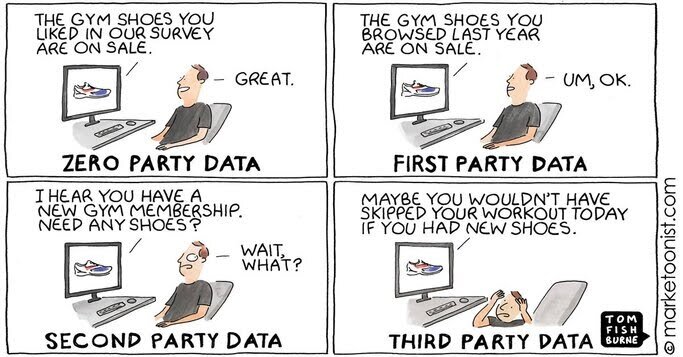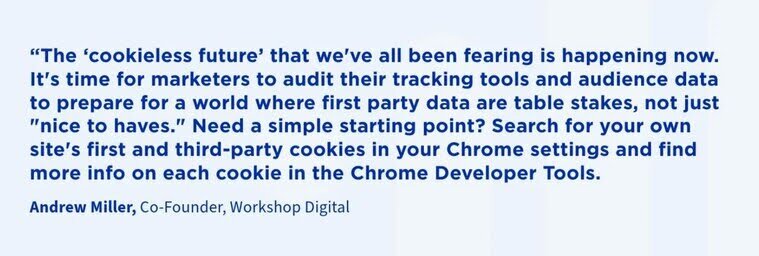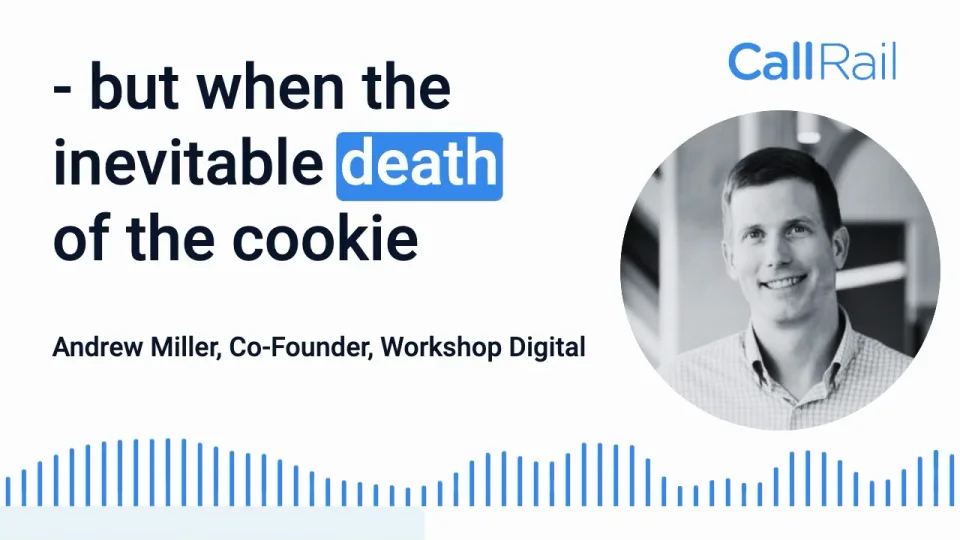July 2024 update: As of July 22, 2024, Google announced it will no longer deprecate third-party cookies. Instead, Google promised to introduce a new feature that lets people make an informed choice that applies across all web browsing. In light of this, we recommend continuing to prioritize the capture of first-party data. Focusing on direct interactions with your customers allows for more reliable and compliant data collection, ensuring your marketing strategies remain effective regardless of industry changes.
In 2025, Google will finally end its use of third-party cookies. With just a year left, agencies need to start preparing because when third-party cookies disappear, it will upend how agencies collect and use consumer data for programmatic advertising. In turn, this could negatively impact the results agencies are able to achieve for their clients.
But your agency — and your clients — can make the transition to a marketing world without third-party cookies more seamlessly and with less disruption if you make some important changes now to the types of data you collect and how you use it. In this article, we’ll catch you up on what's happening, why it matters for your agency, and what steps you need to take to navigate this transition effectively.
Different types of cookies serve different purposes
For decades cookies have played a fundamental role in creating user-friendly experiences on the internet. Cookies help a website remember and auto-fill your username, remember a visitor’s preferences, and remember and suggest products they’ve previously viewed. All of these behaviors make it faster and easier for visitors to navigate through a website and complete what they came to do. However, different types of cookies are used in different ways.
First-party cookies, placed by the website owner, are used to authenticate users or track their behavior. These cookies are generally seen as benign and, in some cases, essential to the user experience.
Third-party cookies, on the other hand, are placed on users’ computers through ads, allowing websites they’ve never visited to track their browsing history and behavior. While these cookies help deliver more relevant online ads to users, they have also raised significant privacy concerns among consumers and regulators.

Source: The Marketoonist
How we got here and where the cookie saga goes next
The era of loose consumer data practices is ending. The slow demise of third-party cookies began in 2016 with the European Union's General Data Protection Regulation (GDPR), which aimed to give EU citizens more control over their data. In response, browsers began phasing out third-party cookies. Apple's Safari browser, for example, started blocking all third-party cookies in early 2020.
The major holdout has been Google’s Chrome browser, the most popular in the world with nearly two-thirds of the market. Google has delayed its deprecation plans for years, aiming to create an alternative that balances advertisers' needs with consumer privacy concerns.

Uncertainty still lies ahead for agencies
The loss of third-party cookies will pose challenges, particularly for those agencies relying on traditional remarketing and retargeting strategies. Your agency may also be concerned about maximizing your clients’ ad budgets without third-party data to fuel these campaigns.
You’re not alone in your uncertainty. Many in the ad tech industry are warning that, despite the slow rollout, they aren’t prepared to ramp up on Google’s solution, known as The Privacy Sandbox. The Privacy Sandbox will allow Chrome users to manage what ad topics they’re interested in seeing while giving advertisers a way to target consumer segments without the use of tracking cookies. Essentially, the Chrome browser will act as the intermediary between advertisers and consumers.
Without third-party cookies, industry experts believe that audience accuracy will decline, making audience-based targeting and smart bidding strategies less transparent as Google's Privacy Sandbox creates a more controlled environment.
It’s time to get personal to personalize ads
The good news is that you can still use customer data to inform your advertising strategy — even without third-party data. But, to gather reliable and privacy regulation-compliant data for your clients, you’ll need to find ways to have more direct interactions with customers.
Instead of relying on ad tech partners to provide insights into your clients’ customers' demographics and behaviors, focus on attracting customers to your clients’ sites, engaging them, and encouraging them to voluntarily share information about themselves. This data, known as first-party or zero-party data, is necessary for effective personalized marketing, especially once third-party cookies disappear.
First-party data is data, which you collect through direct interactions consumers have with your clients’ business, can be collected from phone calls, social media, or your clients’ websites, and it includes a wealth of behavioral insights that you can use to develop detailed customer segments for retargeting campaigns.
Zero-party data is the information that consumers willingly share with you or your clients through user profiles, surveys, forms, and calls. Because this data is shared with companies rather than just collected, as is the case with first-party data, it is highly valuable for agencies aiming to help their clients personalize campaigns accurately.
Your clients probably have access to more first-party and zero-party data than you know—especially regarding phone conversations with customers. Tools like Conversation Intelligence® can transcribe and analyze business calls, helping to unlock valuable insights about your clients’ customers.
In addition, creating new customer experiences that encourage or incentivize consumers to share more personal information, such as filling out forms online or participating in surveys, can also enhance zero-party data collection efforts.
5 strategies for marketing agencies for a post-cookie world
If you give yourself enough time to prepare once Google pulls the plug on third-party cookies, your topline marketing goals and strategies can remain the same. To fill in the data gap left by third-party cookies, you'll need to collect more (and better) first and zero-party data.
The reality is you have more of this data than you realize, but the prioritization of third-party cookies means many agencies haven’t developed the tactics to maximize its use. Here are four strategies to help you collect more first-party and zero-party data for your clients:
1. Conduct a cookie audit
Start by understanding how your clients' sites are using first- and third-party cookies. The Chrome Developer Tools provide more information on each cookie. Next, ask your advertising, CRM, analytics, and data partners about their cookie usage and plans to navigate Chrome’s third-party cookie deprecation.
Once you have this understanding, you can find “next best case scenarios” for any audience targeting or attribution tools that depend on third-party cookies to work properly. You should also start to fully use all first-party tracking available. This includes making sure all of your clients’ business numbers are being tracked. If they are already using Call Tracking, then there’s nothing you need to do to keep it working after third-party tracking is fully depreciated on Chrome.
2. Improve first-party data collection
Getting consumers to your client’s site, app, or product more often will mean you can collect more information about them (as long as you get consent). Creating compelling campaigns will help drive consumers to your client’s properties. You’ll then need to provide them with helpful and relevant content that keeps them around.
Many agencies struggle to understand how consumers find their clients’ businesses. Tools like Call Tracking and Form Tracking can pinpoint which campaigns and keywords drive customers to a business. Call Tracking identifies the ads or keywords prompting calls, while Form Tracking reveals what channels drive form submissions. This data helps you understand clients’ leads and customers better so you can optimize their ad spend more effectively.
3. Prioritize zero-party data collection strategies
Zero-party data eliminates guesswork and middlemen, giving you direct insights from consumers. Zero-party data is incredibly valuable, so it’s okay to give consumers something in return. What offers, content, or topics get people to volunteer information about themselves? You might want to explore using polls on social media or send out surveys in exchange for discounts. Zero-party data strategies should bring you closer to your customers and allow you to create a better, personalized experience for them (without the ick-factor from third-party cookies).
Additionally, using Call Tracking and Form Tracking together, you can determine which campaigns and tactics lead to calls and form submissions. For example, let’s say one of the ads you created for a client inspired someone to click. A few days later they submit a form on your client’s website, then they call your client’s business number. Understanding the journey from first click to conversion lets you prioritize the most effective channels for your clients’ marketing spend.
You can dig even deeper into the conversations your clients are having with leads to compensate for the loss of third-party audience data. Conversation Intelligence can automatically capture keywords, trends, and sentiments from every call, and summarize these in reports that make it quick and easy to understand your audience’s motivations. Using this intel, you can then better target and retarget customers to help drive more business for clients.
4. Maximize insights from customer conversations
If your agency uses chatbots or your clients engage with prospects and customers over the phone, these interactions hold valuable insights that can inform your marketing. Historically, extracting these insights was costly and time-consuming, but tools like Conversation Intelligence have changed the game.
AI-powered Conversation Intelligence can automatically transcribe, summarize, and analyze customer calls, allowing you to easily identify trends and keywords that can improve your marketing campaigns. This eliminates the need to spend hours listening to calls every week.
5. Shift your clients’ marketing budgets to match the new reality
If your clients’ remarketing campaigns start to suffer in a post-cookie world, you may need to shift budget away from the channels and the tools you once relied on. Instead, you can move some of clients’ ad budget to spend on technology that improves their first and zero-party data-gathering capabilities and reallocate the remaining ad budget to channels that help collect zero-party data, such as contact information.
Keep a close eye on your campaign performance this year so you can make changes early and avoid wasted spend as much as possible.
Don’t wait until third-party cookies disappear to improve your marketing strategy in 2025
Get ahead of the change and see how CallRail can give you the data you need to fuel your marketing campaigns for years to come.











